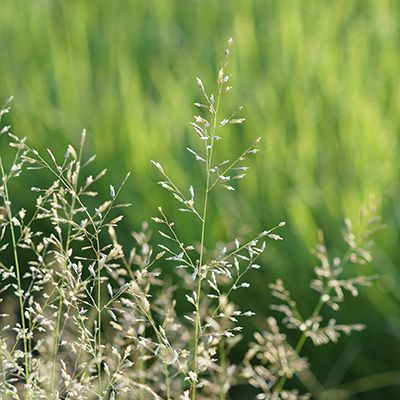


Controlling Annual Bluegrass
Annual Bluegrass (Poa Annua) is one of the most common weeds of lawns, ornamental plantings and gardens. Currently, there is no herbicide (organic or chemical) which will kill Poa Annua and not harm any of the surrounding vegetation. The plant is able to survive low mowing heights (less than one inch) and still re-seed.
Annual Bluegrass starts germinating in late summer or fall as soil temperatures fall below 70°F. It continues to germinate throughout winter, allowing several flushes of germination throughout winter. It is a rapid and prolific seeder. Each small plant can produce about 100 seeds in as few as eight weeks.
Poa Annua has a fairly weak and shallow root system and needs available moisture from rainfall or frequent irrigation to survive. It can grow in compacted soil conditions. In moderately temperate areas where lawns are frequently irrigated, it may persist all year. In warmer areas, it usually dies in summer. Once a few annual Bluegrass plants become established in lawns or ornamental areas, spread can be rapid because of its prolific and rapid seed production. Seeds are spread by mowing, foot traffic, birds and cultivation.
A primary method of controlling annual Bluegrass is the prevention of new infestations. Properties with large lawn areas should have their own lawnmowers and not rely on the mowers used by gardeners who service multiple properties. If solitary plants are found, they should be removed before seed production starts. Open spots should be over-seeded to establish a vigorous turfgrass. Dense turf and ornamentals shades the soil surface, making the establishment of annual Bluegrass seedlings difficult. Use deep and infrequent irrigation to discourage the development of the shallow rooted annual Bluegrass populations. Withhold water until the desirable species are beginning to show drought stress.
Pre-emergent herbicides such as prodiamine or benefin/oryzalin have been successful in limiting germination of annual bluegrass, but they must be applied before weed seeds germinate. Wegman’s commercial products for controlling Bluegrass are:
Amaze grass and weed preventer (benefin/oryzalin) and Easy Living Pre-Emergent Weed Preventer and lawn food (prodiamine).
An organic pre-emergent herbicide, Concern Weed Prevention Plus is also available. Its active ingredient is corn gluten which kills plant seeds as they start to sprout. The Plus is mostly organic material which acts as a slow release fertilizer (8-2-4).
Summarizing then, the most effective method for controlling annual Bluegrass in the lawn is to apply all of the following procedures:
- Hand pull any tufts of Bluegrass which appear in the lawn as soon as they appear.
- Irrigate the lawn less frequently for longer periods to give it a deep soaking; do not water again until the main lawn shows drought stress.
- Have your own personal lawnmower for your property.
- Maintain the lawn in a vigorous state.
- Re-seed bare spots as soon as they are produced.
- Apply pre-emergent weed killer during mid-October and again in mid-January.
It may take several years to completely eliminate all of the annual Bluegrass, but your persistence will be its own reward.
P.S. After putting down the pre-emergent herbicide, wait 6 to 8 weeks before reseeding your lawn.